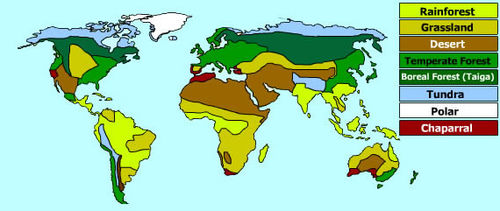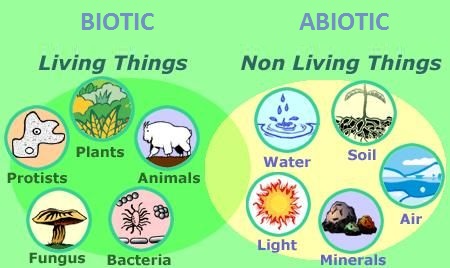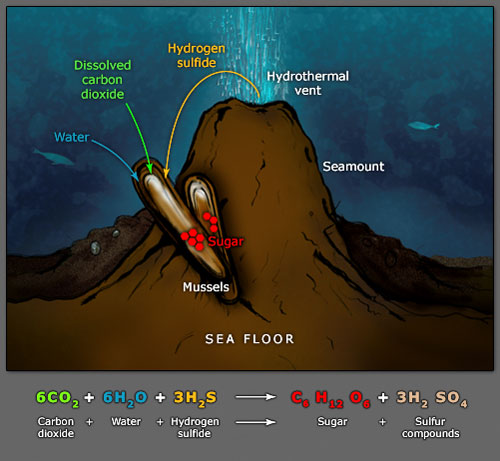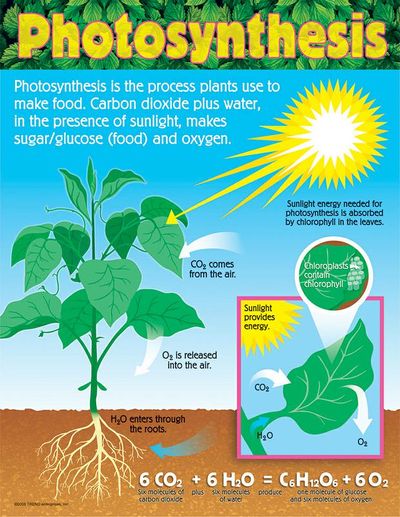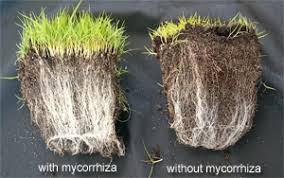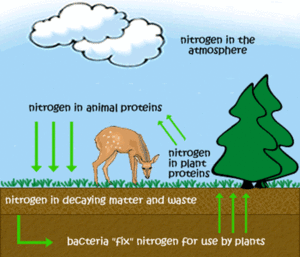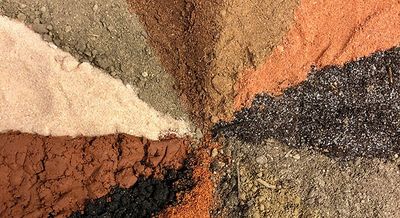Terrestrial ecology: Difference between revisions
No edit summary |
|||
| Line 153: | Line 153: | ||
'''Climate and Weather:''' The condition of the atmosphere over long geological periods. Weather is the daily conditions of the ecosystem such as temperature, pressure, cloudiness and moisture that make up a biomes climate. Both weather and climate can affect an ecosystem. Climate has a long term affect and only if the climate is changing. Weather has a short term affect on an ecosystem such as daily productiveness. For example, if there is an increase in acidic rain from air pollution, this will directly affect pH level within soils and also kill flora and fauna. | '''Climate and Weather:''' The condition of the atmosphere over long geological periods. Weather is the daily conditions of the ecosystem such as temperature, pressure, cloudiness and moisture that make up a biomes climate. Both weather and climate can affect an ecosystem. Climate has a long term affect and only if the climate is changing. Weather has a short term affect on an ecosystem such as daily productiveness. For example, if there is an increase in acidic rain from air pollution, this will directly affect pH level within soils and also kill flora and fauna. | ||
| Line 165: | Line 164: | ||
[[File:Beetlejuice.jpg|400px|]] | [[File:Beetlejuice.jpg|400px|]] | ||
(Namib Beetle Illustration. Roberto Osti, Biomechanics) | (Namib Beetle Illustration. Roberto Osti, Biomechanics) | ||
== '''Putting It All Together''' == | == '''Putting It All Together''' == | ||
Revision as of 15:06, 11 March 2018
Terrestrial Ecology specifies the relations of organisms and their physical environment on land. Terrestrial Ecology can be further defined through categorization of terrestrial biomes and terrestrial ecosystems.
Terrestrial Ecosystems vs Terrestrial Biomes
Terrestrial ecosystems and terrestrial biomes are different from each other. Terrestrial ecosystems can be defined as a community of interaction between many living organisms and nonliving things on land. Terrestrial Biomes can be defined as an area, on land, that can be classified by the animals and plants that live within it. In some cases, there can be a few different ecosystems within a terrestrial biome. This means that biomes are on a larger geographical scale than ecosystems and biomes directly affect or make up the interactions within an ecosystem and the organisms within it.
Tundra: Low temperatures and short growing season, which makes for a less productive ecosystem.
Grassland: Hot summers and cold winters, precipitation plays a vital role in the productivity within this biome.
Desert: Great variability due to the different types of deserts. Low precipitation and productivity solely depends upon the type of desert.
Savanna: Long dry seasons and low amounts of rainfall. Typically are productive due to adaptations of communities. (Ex: Serengeti Plain in Africa)
Tropical: Warm and lots of rainfall. High productivity due to ideal climate conditions and rich soil.
Taiga: Commonly known as Coniferous forests. Long, cold winters and short, cool summers. Productivity is dependent on the season.
Chaparral: Wet winters and dry summers. Low productivity due to long dry summers and low quality in soil. (ex: Mediterranean climate)
Temperate Deciduous Forest: Cool winters and warm summers. Year round precipitation makes for a high productivity.
Polar: Extremely cold temperatures, so cold, the climate averages zero degrees Celsius year-round. Low productivity due to extremely low temperatures.
Factors of Terrestrial Ecosystems
Terrestrial ecosystems can be categorized through biotic and abiotic factors . Biotic factors or biological factors are the autotrophs, heterotrophs, and decomposers of a particular ecosystem. You may remember these as producers or autotrophs, consumers or heterotrophs, and decomposers or detrivores. These biotic factors evidence the differentiation in ecosystems and biomes, for example and in most cases, an autotroph that typically lives in a cold, wet climate would not be able to survive in a hot, dry climate such as a desert or savanna. Abiotic factors are physical components to a ecosystem and these components affect the biological diversity. In short, abiotic factors directly affect biotic factors. Abiotic factors are the unique aspects of the climate, the weather, the type of soil in the region, and the water within the ecosystem.
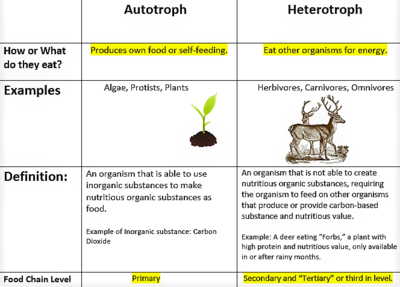
Biotic Factors
Autotrophs
-Autotrophs are organisms that create their own food by converting inorganic compounds into organic compounds. They are primary producers because they reside at the base of the food chain pyramid. There are two types of Autotrophs, Chemoautotrophs and Photoautotrophs.
Chemoautotrophs are bacteria that create energy with the chemical energy within inorganic compounds. This proccess occurs through "chemosynthesis" or the creation of organic compounds by bacteria and these bacteria use energy from chemical reactions that occur without sunlight. They use inorganic compounds like Carbon Dioxide to create sugars. For example, "Sulfur Reducers" are chemoautotrophs and they use inorganic sulfur compounds as a source of energy. Sulfur reducers can be found in locations that release sulfur such as near vents and active volcanoes on the ocean floor. Chemoautotrophs are said to be mainly found within the ocean and in the intestines of animals.
Photoautotrophs are plants and bacteria that contain "chloroplasts" and chloroplasts are able to create energy by converting energy from photons into chemical energy in sugars or other molecules. This occurs in process of photosynthesis. Photoautotrophs play a vital role in terrestrial ecosystems because they are a major provider in energy or food to animals. Plants or photoautotrophs are the primary or base within a food chain pyramid. However there are factors that make each ecosystem unique, so primary or base photoautotrophs will be different within different ecosystems.
Autotrophs can be differentiated by the type of energy they use. Chemoautotrophs use chemical energy and Photoautotrophs use light energy.
Heterotrophs
Heterotrophs are living organisms that gain energy and nutrition through consuming other organisms. The organisms form cells and body parts by using nutrients as "building blocks." Animals and most microorganisms are heterotrophs that can be classified by the organisms they consume. Heterotrophs are secondary and tertiary consumers.
Herbivore: Organisms that eat plants
Example: Deer, Rabbits
Carnivore: Organisms that eat animals
Example: Wolves, Lions
Omnivore: Organisms that eat both plant and animals
Example: Bears, Humans
Detrivores or decomposers that break down plants or animals can also be considered heterotrophic.
Decomposers
"Decomposers," are organisms who feed on dead plant and animal material and also feed on waste. Decomposers break down and partly digest organic material. This feeding process aids in the maintenance of nutrient cycling and restoration of rich soil. There are three types of decomposers, Protists, Fungi, and Bacteria.
"Protists," a single celled organism. Protists look for dead insects or other microorganisms to eat. There are four important types of protists: Flagelletes, Naked Amoeba, Testate Amoeba, and Cilliates.
 Flagelletes: Very common, eat bacteria and are categorized with the "whip-like" tail they have.
Flagelletes: Very common, eat bacteria and are categorized with the "whip-like" tail they have.
 Naked Amoeba: Less common in dry soil and they eat everything. They look like a splattered, blob of jelly.
Naked Amoeba: Less common in dry soil and they eat everything. They look like a splattered, blob of jelly.
 Testate Amoeba: They rapidly reproduce and die. Testate Amoeba are categorized by their "test" or hat-like shell.
Testate Amoeba: They rapidly reproduce and die. Testate Amoeba are categorized by their "test" or hat-like shell.
 Ciliates': More common in moist habitats whether its seasonally or constant. Cilliates have a hairy-looking outer ring.
Ciliates': More common in moist habitats whether its seasonally or constant. Cilliates have a hairy-looking outer ring.
"Fungi" are any single-celled or multi-nucleus organism that decomposes organic material in order to live such as mildew, yeast, mushrooms and mold.
Our "true" fungi are basidiomycetes, ascomycetes, and zygomycetes and these fungi develop relationships with plants which is called mycorrhiza.
 Zygomycetes: Grows rapidly on food through hyphal network.
Zygomycetes: Grows rapidly on food through hyphal network.
 Ascomycetes: They grow in hyphae and are common in soil and aquatic habitats.
Ascomycetes: They grow in hyphae and are common in soil and aquatic habitats.
 Basidiomycetes: They are the most commonly known because they are like our backyard mushrooms and they are important decomposers.
Basidiomycetes: They are the most commonly known because they are like our backyard mushrooms and they are important decomposers.
Mycorrhizal fungi release and distribute nitrogen and phosphorus from dead plant material. This release of nitrogen and phosphorus from mycorrhizal fungi are the primary source within terrestrial ecosystems and in the uptake in these nutrients within plants of these ecosystems. Mycorrhizal relationships also offer defense against insects and other organisms that may be looking for a source of nutrients. Nutrient Cycling is also known as "Ecological Cycling" and this refers to the processes of recycling resources that sustain all life on Earth such as carbon, nitrogen, water and etc. For example, one of the most vital roles within nutrient cycling in terrestrial ecosystems are the role of Mycorrhizal fungi.
"Bacteria" are single-celled microbes that are capable of living in almost all types of environments and temperatures. Without bacteria, humans would not exists and this is due to the role bacteria play in productivity within plants. They work to help with the rate of utilization of Cabron, Nitrogen, Oxygen, and Hydrogen and this is why bacteria are vital for all life.
Abiotic Factors
Climate and Weather: The condition of the atmosphere over long geological periods. Weather is the daily conditions of the ecosystem such as temperature, pressure, cloudiness and moisture that make up a biomes climate. Both weather and climate can affect an ecosystem. Climate has a long term affect and only if the climate is changing. Weather has a short term affect on an ecosystem such as daily productiveness. For example, if there is an increase in acidic rain from air pollution, this will directly affect pH level within soils and also kill flora and fauna.
Soil: It is the basis of which organisms live at and near the surface of the Earth and similar bodies altered by biological, chemical, and/or physical agents and processes. Soil is, has a high level of diversity, because of factors like climate, weather, type of organisms, the type of topography, the parent material and the time from which the ecosystem began. All are large factors in soil formation and how rich the soil is, and this directly affects biotic factors. This can be further defined within Pedogenesis or a term used for studying soil formation. For example, freshwater marshes have a great diversity of organisms and very rich soil. The tundra has a low biodiversity due to its extremely cold weather, climate and poor soil condition.
Water: It is a constituent or a part of a whole. Water is vital for living organisms. Water is a factor of an ecosystem because biotic factors adapt to water conditions. For example, desert fauna are adapted to life with extreme heat and dry climate. Beetles in particular are forced to wait until there is moisture in the air from fog, and they collect this moisture by running to the top of sand dunes and tipping there backs to the sky. As moisture collects on the back of the beetle, the drops run down into the beetles mouth. The harsh climate of the desert has affected the fauna to adapt to hot and dry climate.
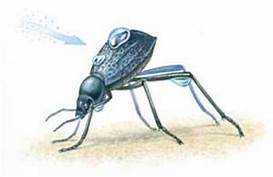 (Namib Beetle Illustration. Roberto Osti, Biomechanics)
(Namib Beetle Illustration. Roberto Osti, Biomechanics)
Putting It All Together
Biome: Grasslands/Wetlands
Type of Ecosystem: Swamps and Marshes
Type of Swamp and Marsh: Freshwater
Climate: Wet, humid season. Dry season.
Freshwater swamps and Marshes are the most productive ecosystems on land. The lower elevation and warm, humid climate creates an ecosystem that is very productive in the simultaneous relationship between biotic and abiotic factors. Marshes resupply groundwater and they manage the flow of water to streams. Marshes play a vital role near "watersheds" by reducing the amount of damage from flooding and this is done through the storing of excess water. Marshes regulate extra sediments and pollutants through decomposition and nutrient cycling. Microorganisms and vegetation feed on the excess nutrients provided by the extra sediments and pollutants such as nitrogen or phosphorous from fertilizers, a very relevant challenge within pollution in agriculture. There is a great diversity of flora and fauna or plants and animals within wetlands. Flora and fauna are the biotic factors within ecosystems or the autotrophs and heterotrophs. The abiotic factors like the humid climate, overly saturated soil, and excess water directly affect the flora and fauna within swamps and marshes. Specifically, freshwater marshes, show the greatest efficiency and productivity for nutrient cycling and converting of resources than any other ecosystem. Detrivores play a vital role in the nutrient cycling and carbon distribution within a freshwater marsh. Ascomycetes and Basidiomycetes, are most common within fresh water marshes, these detrivores convert a large amount of plant litter or "detritus" into Carbon Dioxide and nitrogen as a result of respiration and nitrogen fixing. Respiration occurs at a more productive rate within wet climates opposed to dry climates. When the fungi develop mycorrhizal relationships with plants, in an ecosystem that is humid and has excess water in the soil, the plants and fungus in theory would be working at a greater level of productivity. With more active plants, come higher levels of nutrients. For herbivores, this can create a competitive ecosystem for both space and nutrients. Many insects live in swamps and marshes and many feed on plants. The mycorrhizal relationships within swamps and marshes are not only great for nutrient cycling but also defense against these insects.
When studying and researching terrestrial ecosystems look for specific factors that not only make up an ecosystem but also unique from one another, such as the Biotic and Abiotic factors. These factors show the quality of abiotic factors and proccesses of biotic factors and also the adaptations of biota to a particular ecosystem.
References
Adl, M.S., V.V.S.R. Gupta. 2006, July. "Protists in soil ecology and forest nutrient cycling." http://link.galegroup.com/apps/doc/A149615503/SCIC?u=sunybuff_main&xid=dff4638c.
Beacom, Betsy. 2017, April 25. "Food Chains In Deciduous Forests." https://sciencing.com/food-chains-deciduous-forest-7449795.html
Blanchfield, Deirdre S. 2011 June, 13. "Biotic community." http://ic.galegroup.com.gate.lib.buffalo.edu/ic/scic/ReferenceDetailsPage/ReferenceDetailsWindow?disableHighlighting=&displayGroupName=Reference&docIndex=&source=&prodId=&mode=view&limiter=&display-query=&contentModules=&action=e&sortBy=&windowstate=normal&currPage=&dviSelectedPage=&scanId=&query=&search_within_results=&p=SCIC&catId=&u=sunybuff_main&displayGroups=&documentId=GALE%7CCV2644151534&activityType=BasicSearch&failOverType=&commentary=
Blanchfield, Deirdre S. Gale "Detritivores." 2016. May, 25. http://link.galegroup.com/apps/doc/CV2644150372/SCIC?u=sunybuff_main&xid=6309b795.
Bragg, O.M. Mineyeva, T Yu. Sirin, A.A. Jones, Peter. 2016, Dec. 14. "Towards Ecosystem-Based Restoration of Peatland Biodiversity."
http://mires-and-peat.net/media/map19/map_19_01.pdf
Diffen.com. Diffen LLC.Web."Autotroph vs Heterotroph." https://www.diffen.com/difference/Autotroph_vs_Heterotroph
EPA. 2017. September, 1. "Wetlands Classification and Types." https://www.epa.gov/wetlands/wetlands-classification-and-types#marshes
Freedman, Bill.K. Lee Lerner and Brenda Wilmoth Lerner. The Gale Encyclopedia of Science. 2014."Heterotroph." http://link.galegroup.com/apps/doc/CV2644031108/SCIC?u=sunybuff_main&xid=d35a52f8.
Forseth, Irwin N. 2010. "Terrestrial Biomes" https://www.nature.com/scitable/knowledge/library/terrestrial-biomes-13236757
Gale, World of Biology. 2006. April, 3. "Heterotroph." http://link.galegroup.com/apps/doc/CV2431500310/SCIC?u=sunybuff_main&xid=90cec2db.
Lerner. K Lee. Lerner. Brenda Wilmoth. 2014 The Gale Encyclopedia of Science. "Autotroph." http://link.galegroup.com/apps/doc/CV2644030216/SCIC?u=sunybuff_main&xid=14fc9a52.
National Geographic Society. 2011, January 21. "biome" https://www.nationalgeographic.org/encyclopedia/biome/
Mack, Steve. 2007. Nov, 1. "How do Bacteria Produce Energy Without Mitochondria." http://www.madsci.org/posts/archives/2007-11/1193962676.Mi.r.html
Moreno, J. Perez. Read. D.J. 2003. March, 3. "Mycorrhizas and Nutrient Cycling in Ecosystems- A Journey Towards Relevance." http://onlinelibrary.wiley.com.gate.lib.buffalo.edu/doi/10.1046/j.1469-8137.2003.00704.x/full
Richardson, Curtis J. 2010, October 1. "The Everglades: North America's Subtropical Wetland." http://ll3md4hy6n.search.serialssolutions.com/?ctx_ver=Z39.88-2004&ctx_enc=info%3Aofi%2Fenc%3AUTF-8&rfr_id=info%3Asid%2Fsummon.serialssolutions.com&rft_val_fmt=info%3Aofi%2Ffmt%3Akev%3Amtx%3Ajournal&rft.genre=article&rft.atitle=The+Everglades%3A+North+America%27s+subtropical+wetland&rft.jtitle=Wetlands+Ecology+and+Management&rft.au=Richardson%2C+Curtis+J&rft.date=2010-10-01&rft.pub=Springer&rft.issn=0923-4861&rft.eissn=1572-9834&rft.volume=18&rft.issue=5&rft.spage=517&rft_id=info:doi/10.1007%2Fs11273-009-9156-4&rft.externalDBID=BSHEE&rft.externalDocID=238262864¶mdict=en-US
University of Michigan. 2017. October, 20. "Microbes: Transformers of Matter and Material." https://globalchange.umich.edu/globalchange1/current/lectures/kling/microbes/microbes.html
U.S Department of Interior. 2015. Sept, 28. "What are Wetlands." https://www.nwrc.usgs.gov/fringe/where.html
